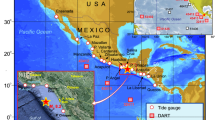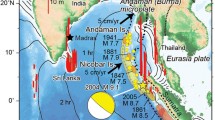Abstract
We studied the tsunami generated by the 1 April 2014 M w 8.2 Iquique (Chile) earthquake using 20 Deep-ocean Assessment and Reporting of Tsunamis (DART) records and applying Fourier and wavelet analyses as well as performing numerical simulations. Deep-water tsunami wave heights were in the range of 0.8–35.0 cm. For the stations located more than 2,200 km from the source, the average wave height was 1.7 ± 1.1 cm. The observed tsunami arrivals were delayed by 1–17 min relative to the simulated ones based on the linear long wave equations, and the delays were proportional to the tsunami travel distances. A small initial depression was observed at DART stations located at distances >10,000 km from the source whereas, traditionally, an initial elevation is expected at stations located seaward of subduction zones. Fourier analyses showed tsunami governing periods of 21.1 ± 1.7 and 14.7 ± 0.7 min, corresponding to a fault length of 60–70 km and a fault width of 40–45 km. While the two 21-min and 15-min signals appeared in most DART stations during ~0.5 h following the conventional arrival times, the 15-min signal was delayed at some far-field stations. Distribution of maximum DART wave heights across the Pacific Ocean did not show a meaningful relation between maximum DART wave heights and directivity or distance from the source.







Similar content being viewed by others
References
An, C., I. Sepúlveda, and P. L.-F. Liu (2014). Tsunami source and its validation of the 2014 Iquique, Chile Earthquake, Geophys. Res. Lett., 41:3988–3994, doi:10.1002/2014GL060567.
Ben-Menahem, A., and Rosenman, M. (1972). Amplitude patterns of tsunami waves from submarine earthquakes, J. Geophys. Res., 77:3097–3128.
Borrero, J.C. and Greer, S.D. (2013). Comparison of the 2010 Chile and 2010 Japan tsunamis in the Far-field. Pure App. Geophys., 170 (6–8):1249–1274.
Gusman, A.R., Satake, K., Murotani, S., Heidarzadeh, M., Gunawan, E., Watada, S. (2014). Rupture process of the 2014 Iquique Earthquake estimated from tsunami waveform and GPS data. AGU Fall meeting 2014, Abstract No. S34B-02, December 15–19, San Francisco, USA.
Heidarzadeh, M., and Satake, K. (2013a). Waveform and Spectral Analyses of the 2011 Japan Tsunami Records on Tide Gauge and DART Stations Across the Pacific Ocean, Pure App. Geophys., 170 (6–8):1275–1293.
Heidarzadeh, M., and Satake, K., (2013b). The 21 May 2003 Tsunami in the Western Mediterranean Sea: Statistical and Wavelet Analyses, Pure App. Geophys., 170 (9–10):1449–1462.
Heidarzadeh, M., and Satake, K. (2014a). The El Salvador and Philippines Tsunamis of August 2012: Insights from Sea Level Data Analysis and Numerical Modeling, Pure App. Geophys., doi:10.1007/s00024-014-0790-2, pp 1–19.
Heidarzadeh, M., and Satake, K. (2014b). Excitation of Basin-Wide Modes of the Pacific Ocean Following the March 2011 Tohoku Tsunami, Pure App. Geophys., doi:10.1007/s00024-013-0731-5, pp 1–15.
IOC-ITIC (2014). 01 April 2014 (UTC), Mw 8.2, Northern Chile Tsunami, available at: http://itic.ioc-unesco.org/index.php?option=com_content&view=article&id=1879:01-april-2014-utc-mw-8-2-northern-chile-tsunami&catid=2129&Itemid=2558, (page visited on May 09, 2014).
IOC, IHO, and BODC (2003). Centenary edition of the GEBCO digital atlas, published on CD-ROM on behalf of the Intergovernmental Oceanographic Commission and the International Hydrographic Organization as part of the general bathymetric chart of the oceans. British Oceanographic Data Centre, Liverpool, UK.
P. L.-F. Liu, Woo, S-B., and Cho, Y-S. (1998). Computer programs for tsunami propagation and inundation, Technical report, Cornell University, USA.
MATHWORKS (2014). MATLAB user manual, The Math Works Inc., MA, USA, 282 p.
Mofjeld, H.O., Titov, V.V., González, F.I., and Newman, J.C. (2001). Tsunami scattering provinces in the Pacific Ocean, Geophys. Res. Let., 28(2):335–337.
NOAA (2014). National Data Buoy Center-National Oceanic and Atmospheric Administration (NOAA) of USA. http://www.ndbc.noaa.gov/dart.shtml (page visited on May 16, 2014).
Okal, E.A., Reymond, D., and Hébert, H. (2014). From earthquake size to far-field tsunami amplitude: development of a simple formula and application to DART buoy data, Geophys. J. Int., 196(1):340–356.
Okal, E. A. (2011). Tsunamigenic earthquakes: past and present milestones, Pure App. Geophys., 168(6–7):969–995.
PTWC (2014). Sea level observations of 01 April 2014 (UTC), Mw 8.2, Northern Chile Tsunami, available at: http://itic.ioc-unesco.org/images/stories/list_of_tsunamis/2014/01apr2014_chile/01apr2014_sl_obs_PTWC_20140407.doc, (page visited on May 09, 2014).
Rabinovich, A.B., Candella, R.N., and Thomson, R.E. (2013a). The open ocean energy decay of three recent trans-Pacific tsunamis, Geophys. Res. Lett., 40(12):3157–3162.
Rabinovich, A.B., Thomson, R.E., and Fine, I.V. (2013b). The 2010 Chilean tsunami off the west coast of Canada and the northwest coast of the United States, Pure App. Geophys., 170(9–10):1529–1565.
Rabinovich, A.B., and Thomson, R.E. (2007). The 26 December 2004 Sumatra tsunami: analysis of tide gauge data from the World Ocean Part 1. Indian Ocean and South Africa, Pure Appl. Geophys., 164:261–308.
Satake, K. (1988). Effects of bathymetry on tsunami propagation: application of ray tracing to tsunamis, Pure App. Geophys., 126 (1):27–36.
Titov, V., Rabinovich, A.B., Mofjeld, H.O., Thomson, R.E., and González, F.I. (2005). The global reach of the 26 December 2004 Sumatra tsunami, Science, 309(5743):2045–2048.
Torrence, C., and Compo, G. (1998), A Practical Guide to Wavelet Analysis, Bull. Am. Met. Soc., 79: 61–78.
USGS (2014). US Geological Survey—Earthquake hazards program, available at: http://comcat.cr.usgs.gov/earthquakes/eventpage/usc000nzvd#summary (page visited on May 09, 2014).
Watada, S., Kusumoto, S., and Satake, K. (2014). Traveltime delay and initial phase reversal of distant tsunamis coupled with the self-gravitating elastic Earth, J. Geophys. Res. doi:10.1002/2013JB010841.
Wessel, P. and Smith, W. H. F. (1991). Free software helps map and display data, EOS Trans. AGU 72: 441.
Acknowledgments
The sea level data used in this study were provided through the USA National Oceanographic and Atmospheric Administration (NOAA). We thank Hiroshi Tsuruoka and Takeo Ishibe at the Earthquake Research Institute (ERI) for assisting in preparation of some figures. Several figures were drafted using the GMT software (Wessel and Smith 1991). We are sincerely grateful to Prof. Alexander Rabinovich, the editor, and two anonymous reviewers for comments that improved this article. This study is supported by the Japan Society for the Promotion of Science (JSPS).
Author information
Authors and Affiliations
Corresponding author
Rights and permissions
About this article
Cite this article
Heidarzadeh, M., Satake, K., Murotani, S. et al. Deep-Water Characteristics of the Trans-Pacific Tsunami from the 1 April 2014 M w 8.2 Iquique, Chile Earthquake. Pure Appl. Geophys. 172, 719–730 (2015). https://doi.org/10.1007/s00024-014-0983-8
Received:
Revised:
Accepted:
Published:
Issue Date:
DOI: https://doi.org/10.1007/s00024-014-0983-8




